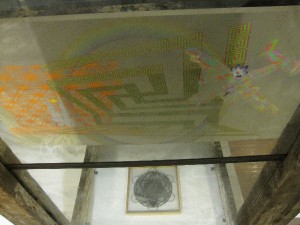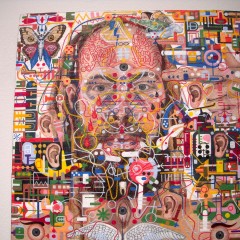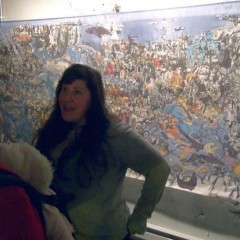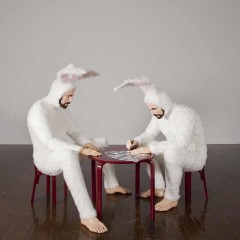Serpents Hallowed Tail Feathers at Pageant Soloveev brings together the surreal and mind-bending works of three Philadelphia artists whose art packs a large “wow” factor. Opened just in time for the much-vaunted end of the Mayan calendar on Dec. 21, 2012, this show includes apocalyptic preparations by Hunter Stabler, paintings freighted with spiritual symbols by Shawn Thornton, and the precisely chaotic works of Nathan Wilson.
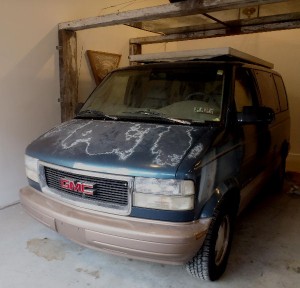
The show takes its name from an installation piece by Stabler, entitled “S.H.T.F. (Serpents Hallowed Tail Feathers).” The work consists of a stained old minivan loaded with survivalist gear that has been set underneath barn joists and an elevated oil painting. Surrounded by the artist’s other works of layered, psychedelic symbolism, the installation is an almost overwhelming array of objects thoroughly imbued with the spirit of their creator.
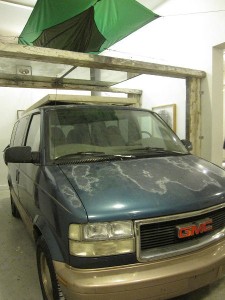
The van component of SHTF looks ready to drive off into the wilderness. On opening night, viewers under supervision could peek inside the van, but since then, the van, which has real firearms on the dashboard, has remained locked and closed. Another gun was strapped to a bicycle on the back, but safely tied down with plastic zip-ties. Even through glass, the sight of real guns is a stark surprise in an art gallery.
The van is under massive wooden joists on which, underneath a green rain fly, lies a fluorescent-hued tangle of symbols: an ancient swastika, an airplane, a circular rainbow, and a cathedral form a strange panorama. The painting of symbols feels almost like a depiction of constellations in the night sky over the van. This painting shifts S.H.T.F.’s emphasis from the van’s conquest-of-nature attitude to one of spiritual meditation.
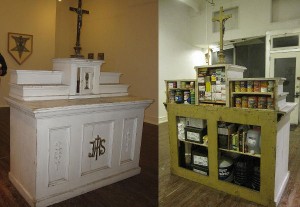
The seeming companion piece to S.H.T.F., the altarpiece,”With Remnants of Liturgy,” includes ample supplies for outdoor survival such as guide-books on mushroom-collecting and plenty of ammunition. Whether the piece is about bringing the icons of religion into a post-apocalyptic world or simply seeing the spiritual side of the end-of-times, the piece’s front-and-back dichotomy bring us beyond the inanimate. “With Remnants of Liturby” delicately ushers us into the portrayal of a mentality that is adorned with religious symbols, and simultaneously stocked up for the apocalypse.
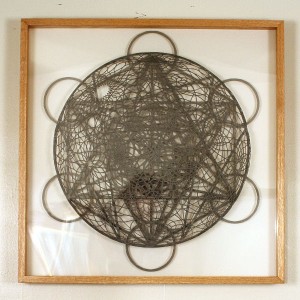
Like the varied and hypnotic images in S.H.T.F.’s ceiling painting, “Oracular Metatronic Hellspectrascopic Enneagram” (above) presents intermingling and conflicting images. The piece presents ornate outlines of triangles, hexagons and circles meshing symmetrically under a squiggly chaos of looping lines. The lines ruthlessly drive the eye around an essentially empty central point. Sunburst and chrysanthemum shapes explode in varying sizes around the piece, resembling the complexity of celestial mapping.
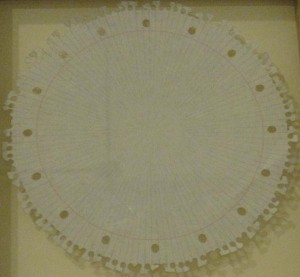
Stabler’s “Oracle/Samsara” visually on the simpler end of the spectrum of his works in this show, is named after the Tibetan concept of samsara or “continuous flow,” which is akin to the modern understanding of beliefs in reincarnation. Stabler’s piece of notebook paper, torn at the edge, never ends, instead forming a perfect circle.
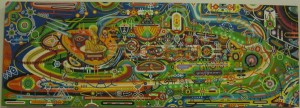
Shawn Thornton’s works come from the experience of a severe debilitating illness, as he previously has told Libby . Thornton’s works are both a depiction of visual hallucinations the artist has experienced and a record of his attempts to regain mental self-control. New and old pieces in the show include further explorations of this subject matter, in the style that he has successfully developed in past years. The artist’s labor-intensive oil paintings structurally resemble brightly-colored circuit-board arrangements and are packed with figures, symbols and characters that convey an obscure narrative.
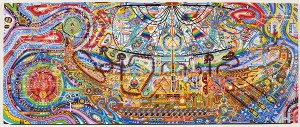
“Witch Doctors at the Eve of the Solar Epoch” depicts a large ark, lifted up on large waves of color. The vessel is rowed forward by a winged creature reminiscent of ancient Mesoamerican iconography while a massive lizard-skulled creature far above acts as a guide. Skulls, stars, triangles and stitches run riot over the piece, each contributing to and vying for control of its overall composition. Thornton’s squiggles and curves lend a Kandinsky-like musicality to the piece, while the precision of his hand-drawn lines give it an air of mechanical perfection.
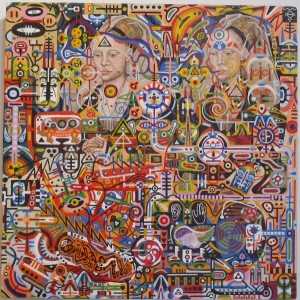
Like Piet Mondrian with a heavy dose of celestial, hallucinatory splashes of organic and colorful growth, each piece seems to originate from a firm composition and grow outward in projecting layers. The canvas-filling foundational shapes, based on broad outlines and curves, resemble organic patterns from the biological world. Close-up, the individual units of line that are Thornton’s smallest tool sometimes operate like living atoms, exerting an influence that balances the work around them. Every square centimeter is rich with visual information, but the shapes can also easily fall into mish-mash as the eye moves over the canvas. The complicated push and pull between hypnotic harmony and frustrating chaos represents the complexity of the artist’s weak handle on reality, and his fraught relation to the overwhelming visions of beauty that he has somewhere perceived and now tries to paint.
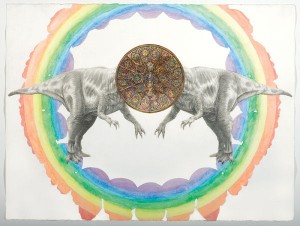
Nathan Wilson’s watercolors and mixed-media sculptures are rousing works that display a high level of proficiency in composition, but in subject matter sometimes seem like they were made by a 13-year-old boy. Two tyrannosaurs rexes colliding into each other in the midst of a rainbow is the subject of “Total Recall,” which shares the name of a cult classic science fiction film. The glorious sunburst of stained glass shows high-level craftsmanship, the dinosaurs are beautifully depicted,and the colors of the rainbow are vibrant. But can any level of craftsmanship redeem a pointless subject?
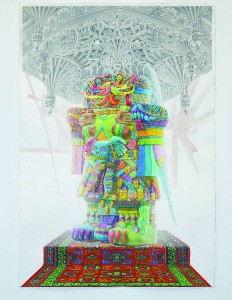
In “Megadethminster Abbey,” the three main components of the piece form a sort of puzzle. The mythical creature at the center feels like a child’s fantasy of a super-strong beast. Combined with visual elements of a mythical warrior, the subject is also an oddly symmetrical creation, with three faces along his vertical center and split and disembodied pairs of hands across his torso. The vaulted and ornate ceiling of a Gothic church is above, while an Oriental rug below reaches a middle ground between the colors and complex patterns of the monster and the church ceiling. A vaguely outlined fourth component in the background of the piece is the red cords that are tied and knotted in the background, as if holding the pieces together.
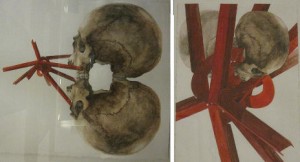
These same ties and knots appear in Wilson’s death-inspired watercolors “Cloven” and “Supercloven,” portrayals of skulls that seem to be animated and held together by red cords, which resemble human arteries. Wilson’s other contribution to the show is his mixed media sculpture, “The Persistence of Historic Preservation/ Utnapishtim Recalled.” A compelling piece that starts in one area of the gallery and stretches over the ceiling to dangle a bag of gear at a second place, the title references the Babylonian mythological figure who survived a world-destroying flood, just like the Old Testament’s Noah. A stone vase with carvings of the Mesopotamian style is encased in plywood on snowshoes, like a relic sent to survive the annihilation of civilization. Above, a boot is dragged away into the air attached to a bag of other goods, like the accompanying objects that couldn’t be preserved in the main of the piece.
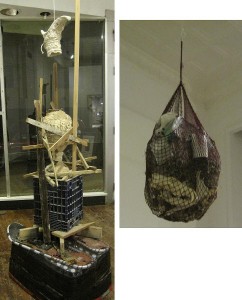
All three artists on show present absorbing works that are slightly tainted by mindsets obsessed with threatening, apocalyptic symbolism. The third-eye vision required to embrace the deeper meanings of these pieces sometimes seems hazy and esoteric. If these artists could step away from recognizable man-made symbols to portray objects purely of their own vision, they might be able to create new shapes and forms that would surprise even themselves.
Serpent’s Hallowed Tail Feathers will be up at Pageant Soloveev, at 607 Bainbridge Street, until Feb. 3.


